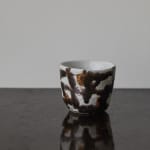Ishiguro Munemaro (1893–1968)
Sake Cup with Persimmon Pattern on White
Sealed sign “Ku” on foot
With a box signed by the artist
W6.2 x H5.1 cm
With a box signed by the artist
W6.2 x H5.1 cm
Further images
Saiji sakazuki, or color-painted sake cup, is titled on the box of this work by the artist. In respect of Ishiguro Munemaro’s saiji, it involves dressing the raw ware with white glaze firing at a high temperature, and decorating with soft glaze. Likewise, the present work is applied with white glaze as a base; the orange glaze is zigzagged throughout the surface on one hand, the purplish black glaze is rendered to weave a meshed grille with lines and planes on the other. The similar motif, inspired by the dangling persimmons, can be seen in Munemaro’s work Jar, Red Persimmon and Black Linear Pattern on White (1959) in the National Museum of Modern Art, Tokyo, which was regarded as one of the signature works of his late period. In this palm-size sake cup, through the process of deconstruction and reconstruction, the concrete image is transformed to be somehow a sign or a symbol. Munemaro brings such an inventive freshness to the work on the one hand, his meticulous depiction of the wrinkles on the surface of the dried persimmons is one of the unique features on the other.
The signature “ku,” both incised on its foot and inscribed on the box, comes from his pseudonym “Ku-an,” which was used since around 1955.
Ishiguro Munemaro (ceramist; 1893–1968)
Also known as Kuan.
Toyama-born ceramist. Built a kiln in Yase district, Kyoto. Researched into ancient asian ceramic making, and reconstructed the Song dynasty Tianmu glaze technique in the modern era. Director of Japan Kogei Association. Designated as a holder of Important Intangible Cultural Property, Iron glazed ceramics in 1955.
The signature “ku,” both incised on its foot and inscribed on the box, comes from his pseudonym “Ku-an,” which was used since around 1955.
Ishiguro Munemaro (ceramist; 1893–1968)
Also known as Kuan.
Toyama-born ceramist. Built a kiln in Yase district, Kyoto. Researched into ancient asian ceramic making, and reconstructed the Song dynasty Tianmu glaze technique in the modern era. Director of Japan Kogei Association. Designated as a holder of Important Intangible Cultural Property, Iron glazed ceramics in 1955.





